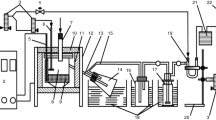Abstract
The formation and deposition of solids in plant equipment is a perennial risk to the cryogenic processing of natural gas. While several tools are available to predict the temperatures at which heavy hydrocarbon solids (HHC) will form, the accuracy of the gas mixture’s compositional characterization can significantly impact the reliability of those predictions. A complete characterization of the mixture is the most desirable scenario but is challenging and expensive to obtain. More typically, C6 hydrocarbons and heavier compounds are lumped into pseudocomponents based on their boiling point to represent the HHC composition of the mixture. Recently, Miethe et al. (Hydrocarb Process, 2015) detailed a new approach based on splitting each pseudocomponent further according to its paraffinic, isoparaffinic, naphthenic and aromatic (PINA) composition. An associated defined component is used to represent each of these sub-fractions to improve the melting temperature prediction accuracy. However, this “Lump + PINAAPI” approach has not been validated for mixtures that contain HHCs beyond C10. This work compares freeze-out predictions based on a complete compositional characterization of a gas mixture with HHCs up to C14 with results obtained using (1) the new Lump + PINAAPI approach and (2) several other freeze-out prediction methods described in the literature. For two gas samples, the fully characterized mixtures were predicted to have melting temperatures of 263.2 K (14.1 °F) and 260.1 K (8.5 °F), respectively. At the same time, the Lump + PINAAPI predictions were 153.4 K (− 183.6 °F) and 157.4 K (− 176.3 °F), respectively. The large discrepancy between melting temperature predictions highlights the need to either (1) obtain full characterization of natural gas mixture compositions where possible, and/or (2) to develop an improved set of correlations pseudocomponent correlations for predicting freeze-out in natural gas mixtures.






Similar content being viewed by others
Data Availability
Not applicable.
References
A.J. Kidnay, W.R. Parrish, Fundamentals of Natural Gas Processing (CRC Press, Boca Raton, 2006)
C. Baker, A. Siahvashi, J. Oakley, T. Hughes, D. Rowland, S. Huang, E.F. May, Advanced predictions of solidification in cryogenic natural gas and LNG processing. J. Chem. Thermodyn. 137, 22–33 (2019)
C.L. Yaws, C. Gabbula, Yaws’ Handbook of Thermodynamic and Physical Properties of Chemical Compounds (Knovel, New York, 2003)
F. Chen, C.M. Ott, Lean gas. LNG Industry, (2013)
W. Ransbarger, A fresh look at LNG process efficiency. LNG Industry, (2007)
I. Miethe, G. Lauermann, B. Jungfer, Improve the calculation of solids precipitation in gas compositions, Hydrocarb. Process., no. May/June, (2015)
M.R. Riazi, T.E. Daubert, Prediction of molecular-type analysis of petroleum fractions and coal liquids. Ind. Eng. Chem. Process. Des. Dev. 25, 1009–1015 (1986). https://doi.org/10.1021/i200035a027
C. Antoine, Vapor pressure: a new relationship between pressure and temperature. C. R. Acad. Sci. 107, 681–685 (1888)
Aspen Properties V12, AspenTech, Bedford, MA, USA, (2021)
PURE38 Databank, Aspen Properties
AIChE DIPPR® data compilation project, Aspen Properties
B.E. Poling, J.M. Prausnitz, J.P. O’connell, Properties of Gases and Liquids (McGraw-Hill Education, New York, 2001)
KBC Advanced Technologies, Infochem Multiflash 7.0. Walton-on-Thames, England, https://www.kbc.global/software/advanced-thermodynamics/ (2018)
D.L. Morgan, R. Kobayashi, Triple point corresponding states in long-chain n-alkanes. Fluid Ph. Equilibria 63, 317–327 (1991)
K. Won, Thermodynamics for solid solution-liquid-vapor equilibria: wax phase formation from heavy hydrocarbon mixtures. Fluid Ph. Equilibria 30, 265–279 (1986)
T. Brown, V. Niesen, D. Erickson, The effects of light ends and high pressure on paraffin formation, in SPE Annual Technical Conference and Exhibition, (OnePetro, 1994)
C. Lira-Galeana, A. Firoozabadi, J.M. Prausnitz, Thermodynamics of wax precipitation in petroleum mixtures. AIChE J. 42, 239–248 (1996)
ThermoFAST 2.0. (2022) Fluid Science and Resources, The University of Western Australia, https://www.fsr.ecm.uwa.edu.au/software/. [Online]. Available: https://www.fsr.ecm.uwa.edu.au/software/thermofast/
M.R. Riazi, T.A. Al-Sahhaf, Physical properties of n-alkanes and n-alkylhydrocarbons: application to petroleum mixtures. Ind. Eng. Chem. Res. 34, 4145–4148 (1995). https://doi.org/10.1021/ie00038a062
K.S. Pedersen, K.S. Pedersen, P.L. Christensen, J.A. Shaikh, P.L. Christensen, Phase Behavior of Petroleum Reservoir Fluids (CRC Press, Boca Raton, 2006)
Acknowledgements
The authors thank David J. Zhu, Peter E. Falloon, and Xiong Xiao for upgrading ThermoFAST Software to enable the freeze-out calculation methods tested by this work. Special thanks to David J. Zhu for his assistance in editing this paper. We thank the Future Energy Exports Cooperative Research Centre for providing access to the free ThermoFAST software package developed by the Fluid Science Research group at the University of Western Australia. This is FEnEx CRC Document 2022/RP1.CM1.3.2-FNX-001.
Funding
This work received no direct funding. EFM is partially funded by the Future Energy Exports CRC.
Author information
Authors and Affiliations
Contributions
HAA conducted the research, supervised by NAE-E, TMA-F and EFM. HAA and EFM wrote the main manuscript text. All authors reviewed the manuscript.
Corresponding authors
Ethics declarations
Competing Interests
The authors have no competing interests as defined by Springer, or other interests that might be perceived to influence the results and/or discussion reported in this paper.
Ethical Approval
Not applicable.
Additional information
Publisher's Note
Springer Nature remains neutral with regard to jurisdictional claims in published maps and institutional affiliations.
Appendix: 45 Discrete Compounds Added to ThermoFAST to Enable Full Method Freeze-out Calculations
Appendix: 45 Discrete Compounds Added to ThermoFAST to Enable Full Method Freeze-out Calculations
See Table 8.
Rights and permissions
Springer Nature or its licensor (e.g. a society or other partner) holds exclusive rights to this article under a publishing agreement with the author(s) or other rightsholder(s); author self-archiving of the accepted manuscript version of this article is solely governed by the terms of such publishing agreement and applicable law.
About this article
Cite this article
Attalla, H.A., El-Emam, N.A., Aboul-Fotouh, T.M. et al. Performance Tests of Gas Characterization Methods for Predicting Freeze-out in LNG Production. Int J Thermophys 44, 25 (2023). https://doi.org/10.1007/s10765-022-03127-5
Received:
Accepted:
Published:
DOI: https://doi.org/10.1007/s10765-022-03127-5




